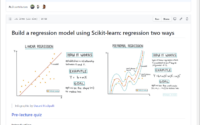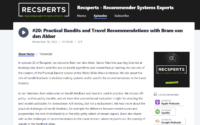A new promising book: “Recommender Algorithms – 2026 Practitioner’s Guide”
I received a very interesting new book “Recommender Algorithms: 2026 Practitioner’s Guide” by Rauf Aliev. I have skimmed only the first hundred pages, so this note is an early impression. The book is, in short, a practitioner’s manual. It focuses on algorithms and code, not product narratives. The chapters move from classical baselines and nearest-neighbour methods through matrix factorisation and pairwise ranking, then on to sequence-aware and transformer-style models, and further to text/LLM and multimodal setups. Evaluation is treated as part of the build, with ranking metrics sitting next to regression or classification where appropriate. The writing stays close to implementation, with compact explanations and runnable snippets.
My verdict after this initial pass is quite positive. The volume is a serious, useful contribution for engineers who want to build systems, not just read about them. The algorithmic core is explained clearly, the coding examples look serviceable, and the progression from intuition to implementation is well judged. There are small errors and occasional rough edges in phrasing—exactly the kind of imperfections one expects from a single-author technical book without a large editorial pipeline. They do not undermine the technical content. Very little is publicly known about the author and, as far as I can tell, there is no visible prior activity in the academic recommender-systems community. That absence may limit scholarly positioning, but it should not discourage practitioners: this is not aiming to be a comprehensive literature survey. It is an implementation-forward guide, and on that axis it succeeds.
I would also recommend it to students and researchers. The first hundred pages proceed in small, testable steps and keep the math tight but accessible. If you want to develop a solid working understanding—why cosine can fail, what implicit feedback changes in the loss, how pairwise ranking differs from rating prediction—the early chapters provide a clean ramp. Researchers who feel “algorithm rich but pipeline poor” may also find it valuable as a companion when reproducing baselines or wiring sequential models; the coverage of transformer-style recommenders aligns with established references such as SASRec and BERT4Rec, which have become standard touchpoints for sequence modelling in RS.
In sum: yes, the book reads as an engineer’s field guide, but it doubles as a compact teaching resource for students and a practical bridge for researchers who want to ground theory in working code. My first-hundred-pages verdict stands: it is worth your time and likely worth the purchase. I will continue reading beyond page 100 and may return with a longer review. In the meantime, I would welcome feedback in the comments—especially from readers who have gone further into the LLM, graph, and counterfactual chapters. What worked, what needed fixing, and what did you add on top?
Update 2025-11-24: The author just made the following announcement on LinkedIn:
I’ve released an open-source electronic companion app to my book “Recommender Algorithms”! It’s a kind of sandbox where you can experiment with different recommendation algorithms using various settings, and for each algorithm you can explore a specific visualization that helps you understand how it works.
App: https://recommender-algorithms.streamlit.app/
Github: https://github.com/raliev/recommender-algorithms
For example, for algorithms like ItemKNN, SLIM, or EASE, the key visualization is a heatmap of the learned item-item similarity matrix. This allows you to see which item pairs the model considers “similar” (or “influential” to each other). For SLIM, it’s also useful to look at the Sparsity Plot, which shows that the similarity matrix W is indeed sparse.
For Association Rule algorithms (Apriori, FP-Growth, Eclat), the visualization isn’t a chart at all, but rather interactive tables with discovered Frequent Itemsets and generated Association Rules, which can be filtered and sorted.
In addition, the app includes a parametric “dataset generator” called Dataset Wizard. It works like this: there are template datasets describing items through their features — for example, recipes by flavors, or movies by genres. The system then generates random users with random combinations of the same features, and there are many sliders that let you control how contrasting or complex the distributions are.
Next, a user-item rating matrix is created — roughly speaking, if a user’s features match an item’s features, the rating will be higher (shared “tastes”); if they differ, the rating will be lower. There are also sliders for adding noise and sparsity — randomly removing parts of the matrix. The recommender algorithm itself doesn’t see the item or user features (they’re hidden), but they’re used for visualization of results.
The third component of the app is hyperparameter tuning. Essentially, it’s an auto-configurator for a specific dataset. It uses an iterative optimization approach, which is much more efficient than Grid Search or Random Search. In short, the system analyzes the history of previous runs (trials) and builds a probabilistic “map” (a surrogate model) of which parameters are likely to yield the best results. Then it uses this map to intelligently select the next combination to test. This method is known as Sequential Model-Based Optimization (SMBO).
The code is open source and will continue to be expanded with new algorithms and new visualizations.
About the author, Rauf Aliev: According to Rauf, he has spent the past twenty-five years working in e-commerce automation, where he currently serves as Solution Architect and Chief Software Engineer at EPAM Systems. His engagement with search and recommender systems is professional rather than academic, rooted in engineering work that frequently overlaps with information-retrieval challenges. He describes himself as largely self-taught in these areas, having filled the gaps through extensive reading, experimentation, and critical reflection outside working hours. Although not affiliated with a research group, he notes that his daily work for clients has long intersected with problems familiar from the research literature. Rauf has made much of his material publicly available on two non-commercial websites, hybrismart.com and testmysearch.com, which collect around two hundred articles and tools related to e-commerce, search, and retrieval. His earlier book, Beyond English: Architecting Search for a Global Audience, originated from a series of blog posts on multilingual search, notably the 2019 essay “The Challenges of Chinese and Japanese Searching.” The Recommender Algorithms 2026 Practitioner’s Guide continues this pattern of consolidating and expanding his own applied work for a broader audience. Further background, including his professional résumé, can be found on his LinkedIn profile at linkedin.com/in/raufaliev.





